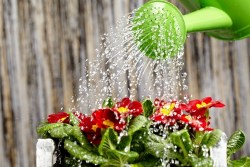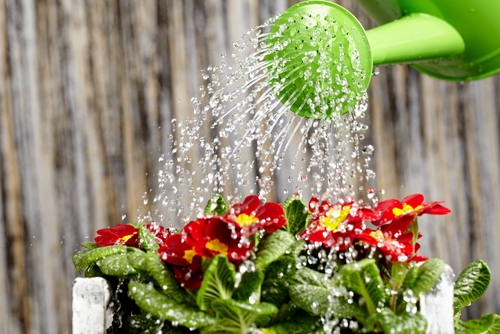Send your question to Umbra!
Q. Dear Umbra,
We use a dehumidifier in our basement. How can we use the water it collects — drink it? Use it in the garden? For our pets?
Jean K.
Newington, Conn.

Gray water is safe for inedible plants to drink, but you probably shouldn’t try it yourself. (Photo by Shutterstock.)
A. Dearest Jean,
I hereby bestow enormous thanks upon you, for you have given me an opportunity to revisit one of my favorite topics — the ever-useful, though disgustingly named, gray water. This is an especially pertinent topic during these times of drought and other wild weather.
Gray water, as you might know, is the lightly used wastewater that comes from our showers, dishwashing, laundry, and so forth — basically, anywhere but the toilet. (That stuff is even more disgustingly known as “black water.”) Water in a dehumidifier counts as gray water too, though it is snatched from the air instead of dispensed from our pipes. Whatever the source, it seems a shame to pour this water down the drain. It is still useful! Despite being gray or grayish! So what can we do with it?
To answer your questions: No, it is not drinkable. For you or for your pets. But it should be okay for watering plants and a few other uses, which I shall detail in a moment.
However, I must first pause to let you know that I contacted several of our friends in the dehumidifier industry, who do not condone this practice. “We do not recommend using the water for any purpose,” says Tom Kelly, vice president of the Air Conditioner Group at Haier America. “There are issues with the cleanliness of the bucket and the possible growth of microorganisms. The water flowing off the coil will tend to wash any airborne contaminants that have been deposited on the fans into the bucket. The third issue is the possibility of the copper and aluminum leaching into the water as it condenses on and runs off the coil.”
To recap: The risks are microorganisms, airborne contaminants, and heavy metals such as copper and aluminum. (If the rest of Tom’s quote has you scratching your head, perhaps you’ll find this diagram handy.)
With all due respect, these are risks that most hardy plants deal with on a daily basis, which is why many people seem to be comfortable using dehumidifier water on well-established houseplants and in their gardens — although, as with all gray water, you should not use it on edible plants. Whether it is safe to use on marijuana plants appears to be a topic of great interest, according to the startling results of one of my Google searches; I did not investigate further, lest the Grist higher-ups get the wrong idea about what goes on down here in the library stacks.
To keep the grunginess of your gray water in check, try to keep your dehumidifier as clean as possible. (Here are a few other tips for safely using gray water from other sources.) You might also want to test the pH of the water — if it’s too high (generally above 7.0), your plants probably won’t like it. Of course it all depends on where you live, what you’re growing, and what’s already in your soil.
Many happy people also recommend other uses for this collected condensate. Some use it to wash their cars or floors, though you’d want to be careful about paints and finishes; others flush the toilet by pouring water into the bowl (not the tank); still others fill their irons or presoak laundry with it. Being a cautious type, I would avoid those last two ideas, on account of the whole “microorganism, contamination, heavy metal” warning from earlier. No need to knowingly introduce those items into your wardrobe.
So Jean, it looks like you’re left with two basic options: toilets and tulips. Which, as it happens, is the working title of my autobiography. Thanks for being thoughtful about your water use.
Parchedly,
Umbra



